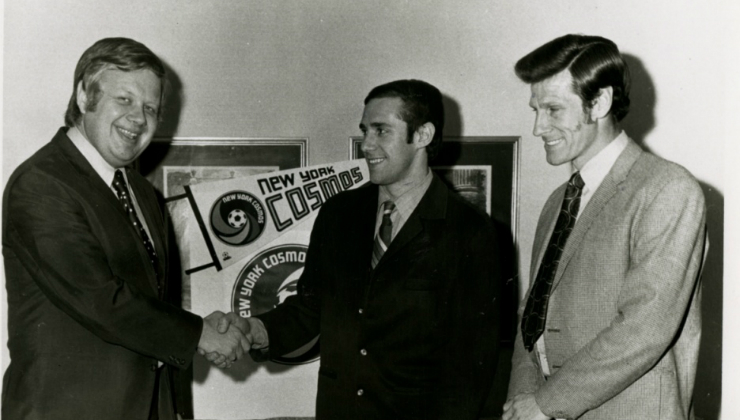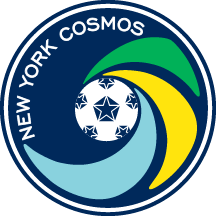News
Former Cosmos General Manager Clive Toye Played Key Role In Professional Soccer's Early Years

If it wasn't for the likes of Clive Toye and Phil Woosnam, the New York Cosmos probably wouldn't be around today.
In fact, professional soccer in the United States wouldn't be around, at least as we know it.
Those two men were integral during the North American Soccer League's outset in the 60s and 70s.
Clive Toye, who attended the NASL 50th reunion in Frisco, Texas in October, recently reminisced about the early days of modern professional soccer.
"What people too easily overlook was that the NASL's mission was to build the game and then at the end of it, make some money for the owners," he said. "In some cases, the owners didn't think that way. People like Lamar Hunt, and a quite a few others wanted to rebuild for the future as did a few people who were working there. The NASL as a crusade was a magnificent success. As a business, it eventually failed as a single entity. But what it left behind is a knowledge of the game that didn't exist in this country before and enthusiasm for the game which never existed before and the World Cup coming kept the thing moving into the future, which came about because of the NASL. The NASL started working on the World Cup back in '69, long time before '94 came along."
In 1969, Toye, Woosnam, and some other soccer officials held a meeting to discuss the future of soccer in the U.S., even if it was in a precarious position at that time.
"One target was to build a club in New York, and the other target was to get the World Cup," Toye said. "Everything we did was aimed in those two directions, believing that those two things would create the mist of interest in the game. It was my job eventually to run New York and sign Pele."
Toye did just that as general manager of the Cosmos, who joined the NASL in 1971 before winning their first league title the next season. The Cosmos signed Pele to a three-year contract in 1975.
"Our collective jobs was to get the World Cup, which would not have taken place had it not been for the North American Soccer League and the few people in the federation who worked with us to bring it about," Toye said. "There are people who weren't even involved who think the NASL was a failure. If losing money is a failure, absolutely. If building the game for the future was a failure, then you don't know what you're talking about mate."
Woosnam, Toye, and the rest of pro soccer was living on the edge.
"The whole thing almost disappeared, and Phil Woosnam and I got charged with keeping it going, expanding it, and building the game," Toye said.
A half a century ago, soccer wasn't fashionable in North America. The sport was played in cities, mostly by recent immigrants and ethnic groups. There were a handful of native-born Americans who dared to play the beautiful game.
"It wasn't fashionable," Toye said. "It wasn't known in most places. People were saying to us, 'What's soccer? Oh, you kick a ball, Oh yeah, hmmm.' I remember when we reached the [1968] final when Baltimore played against Oakland, a local guy for the Baltimore Sun said, 'If you win, you'll be world champions. I said, not quite.
"From Baltimore to buy a soccer ball I had to go to Max Doss [soccer store] in Manhattan, East 86th Street. That was the nearest shop to Baltimore where you could get a soccer ball. People don't understand how basic it was. The game had been here. People were working very hard at it. But those who were here were working hard in their own communities. Bless them. And building good teams, good players in St. Louis and parts of New England. Even the Naval Academy in Annapolis. I don't know whether it was the vision, the time, the money, whatever - or inclination to take it beyond their Italian American League, German American League, Greek Americans, wherever it was. They were happy with that. We weren't happy with that. We wanted to encourage all of them to help us and by God they did as we made the game a national game, not a local or ethnic game."
Today, the sport is light years from what it was five decades ago. There are soccer fields abound, soccer stores seemingly all around, and there seems to be soccer 24/7 on television.
"If what was happening today had been suggested to someone 50 years ago they would have suggested you go see a doctor to get your mind seen because there was no possibility whatsoever," Toye said. "If you talk today on what's going to happen in 50 years' time people might listen this time because so much happened in the past 50 years. In my opinion, the NFL, American football, is severely in decline. It's because so many more kids are playing soccer and not playing American football."
In fact, Toye has seen that first hand where he lives in South Florida as there is a huge soccer field nearby. One of his doctors has an 11-year-old daughter who plays soccer.
"When I see him, he talks about soccer," he said. "So, I had to see her play, right? So, I am watching these 10-, 11-year-old girls play. I had only been there for a few minutes and the ball went out of play. The forward stopped for a moment and the midfield came running up behind her and said, 'Go!' The winger ran and the midfielder threw the ball over the defender's head right into the path of the outside right so she could run. She ran and crossed the ball and I thought, 'Bloody hell. It wasn't just a bunch of girls kicking the ball around.' It was wonderful to watch, the way they were playing. They did with such composure, with such complete professionalism and at that age.
"Boy oh boy, it was worth it after all."


